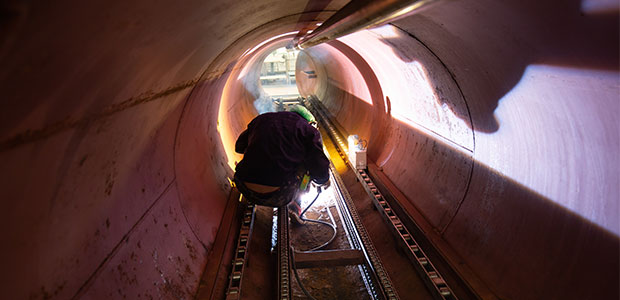
The Dangers of Working in Confined Spaces
Confined spaces pose a number of physical and environmental hazards to a worker—and it’s critical that employers understand the risks, those most vulnerable and hazard mitigation techniques.
- By Lauren Holman
- Mar 17, 2020
Have You Ever Been Required to Work in a Confined Space?
When we think of confined space, it is easy to only imagine them as being very small areas that are only present underground. Although underground confined spaces are many, tanks, silos, storage bins, vaults, and water supply towers are a handle of confined spaces that exist above ground. Thus, confined spaces do not necessarily have to be small areas to fall under this category.
A confined space is any area that has constrained or limited entry or exit. Even if the entry is only partially closed, a space is still considered confined as the worker is often unable to enter or exit freely. Most confined spaces were not meant for human inhabitance but are temporarily occupied by workers as they complete employment duties. Due to entry and exit barriers, confined spaces pose a multitude of safety hazards. In essence, the space itself might be poorly constructed and prone to collapse, the area may contain poisonous substances that have built-up or collected over time, or the work required to be done in the space could be dangerous in the first place. All these risks are amplified as the confined space gets smaller, more difficult to exit, or less accessible to other workers.
Here Are the Risks
For those companies who do not employ workers who perform their jobs in confined spaces, it is easy to forget how dangerous working in these types of spaces can be. Each year, approximately 92 workers die in confined space-related workplace incidents, according to the US Department of Labor. This is equivalent to nearly two workers every week.
The troubling reality is that any hazard that could otherwise be encountered in the workplace can also occur in a confined space. But, the critical thing to consider is that these hazards will be much more severe in an area where entry and exit are limited. Situations where workers are overcome with poor air quality or inadequate oxygen supply, radiation, toxic gases, extreme temperatures, structural or construction issues, explosive or flammable substances, or electrical hazards can become deadly in a matter of seconds if the worker is unable to evacuate quickly.
For instance, poisonous gases are much more likely to build up in a smaller, poorly ventilated space than outside or in a large building. This build-up can occur quickly, and if a worker is unable to escape the confined space, they could very quickly be overcome by the toxic gas. Furthermore, the nature of the space makes a co-worker's ability to rescue the distressed employee exceedingly more difficult.
Workplace conditions can change very quickly. It is also important to point out that communication barriers may come into play if an employee is working alone in a confined space.
Who Is Most Vulnerable?
The most common injuries and fatalities that occur as a result of confined space-related incidents are drowning in water tanks, suffocating in grain silos, and the collapse of trenches or temporary structures. Thus, agriculture workers are at a very high risk of suffering a confined space-related accident on the job. Purdue University's Agricultural Safety and Health Program specifically tracks instances where confined spaces have brought harm to employees who work in agriculture. In 2018, they recorded 61 accidents, which represented a 13 percent increase from 2017.
Thirty of these reported accidents were grain entrapments, and seven were caused by poor air quality and toxic chemical build-up in a confined space. You can learn more about the dangers of working alone in agriculture here.
Electrical workers also bear a significant amount of risk. Many of their daily job tasks require working in small spaces, such as completing the wiring for a building. If any worker is required to work in a confined space, there is a standard list of procedures that employers should adhere to in order to protect that worker’s safety.
Hazard Mitigation Techniques
Managing the risks associated with working in a confined space begins with a thorough hazard assessment for each confined space to make all workers aware of the risks at hand. Furthermore, written and verbally communicated work protocols must be present. These protocols should identify entry and exit barriers, the ventilation systems in place, specific rescue procedures, standby or “on-watch” workers and information regarding required PPE—such as harnesses, lifelines, or lifting equipment. Regular assessments of the confined space should be conducted to ensure that there is no build-up of poisonous gases or substances, and to confirm that ventilation systems are working properly.
If you have workers that occasionally perform their jobs in confined spaces, the implementation of a worker monitoring solution is an additional way to mitigate your company’s risk. Using an automated check-in system is a fail-proof way to ensure the safety of your people on the job. Workers can check-in at predetermined time intervals throughout the day to confirm their safety. Additionally, required check-in times can be adjusted depending on the ‘riskiness’ of the activity at hand. If an employee is working in a confined space with dangerous equipment, they can decrease the time between each check-in interval to confirm their safety more frequently.
A worker monitoring solution is a valuable addition to your company—especially if you employ workers who perform their jobs in confined spaces. Because the dangers associated with working in these types of environments are numerous, organizations must ensure they are taking the necessary steps to protect the safety of their staff.